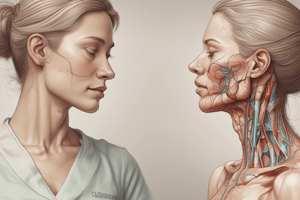Podcast
Questions and Answers
Which of the following regions of the abdomen is located in the upper right quadrant?
Which of the following regions of the abdomen is located in the upper right quadrant?
- Left iliac region
- Left lumbar region
- Right hypochondriac region (correct)
- Umbilical region
The term 'flexion' refers to a movement that increases the angle between two body parts.
The term 'flexion' refers to a movement that increases the angle between two body parts.
False (B)
Name the three regions of the abdomen located in the middle section.
Name the three regions of the abdomen located in the middle section.
epigastric region, umbilical region, hypogastric region
The ______ region is located to the left of the umbilical region.
The ______ region is located to the left of the umbilical region.
Match the movement term with its correct description:
Match the movement term with its correct description:
What is body perception primarily concerned with?
What is body perception primarily concerned with?
Cognitive Behavioral Therapy (CBT) is aimed at altering positive body image thoughts.
Cognitive Behavioral Therapy (CBT) is aimed at altering positive body image thoughts.
What condition involves an obsessive focus on perceived flaws in one's body?
What condition involves an obsessive focus on perceived flaws in one's body?
The __________ movement advocates for acceptance of all body types.
The __________ movement advocates for acceptance of all body types.
Match the following terms with their definitions:
Match the following terms with their definitions:
Which of the following is NOT a biological factor influencing body perception?
Which of the following is NOT a biological factor influencing body perception?
Extreme dieting can be a consequence of poor body perception.
Extreme dieting can be a consequence of poor body perception.
Name one method used to assess body image concerns.
Name one method used to assess body image concerns.
Study Notes
Body Parts and Regions
- The human body is divided into various parts, including the head, neck, torso, arms, and legs.
- Understanding body regions helps in the diagnosis and treatment of medical issues.
- Anatomical terms are essential for accurately describing locations and functions of structures.
Nine Regions of the Abdomen
- Right Hypochondriac Region: Located in the upper right, contains the liver and gallbladder.
- Epigastric Region: Central upper region, houses the stomach and part of the liver.
- Left Hypochondriac Region: Upper left part, contains the spleen and stomach.
- Right Lumbar Region: Mid-right area, includes parts of the large intestine and kidney.
- Umbilical Region: Central region around the belly button, includes small intestine and transverse colon.
- Left Lumbar Region: Mid-left area, also includes parts of the large intestine and kidney.
- Right Iliac Region: Lower right section, includes the appendix and cecum.
- Hypogastric Region: Lower central section, contains bladder and reproductive organs.
- Left Iliac Region: Lower left part, includes parts of the sigmoid colon.
Terms Related to Movement
- Flexion: Decreasing the angle between body parts; for instance, bending the elbow.
- Extension: Increasing the angle between body parts; straightening the elbow.
- Abduction: Moving a limb away from the midline of the body.
- Adduction: Moving a limb toward the midline of the body.
- Rotation: Turning a part of the body around its axis; neck rotation is a common example.
- Circumduction: Circular movement combining flexion, extension, abduction, and adduction, such as arm circles.
- Pronation: Turning the palm downwards or backwards.
- Supination: Turning the palm upwards or forwards.
- Dorsiflexion: Elevating the foot towards the shin.
- Plantarflection: Pointing the toes downwards.
Body Perception
Definition
- Awareness and interpretation of one's own body, encompassing size, shape, and spatial positioning.
Key Concepts
- Body Image: A mental construct of one's physique shaped by personal experiences, societal influences, and media representations.
- Somatosensory Perception: The brain's ability to process sensory information from the body, including sensations of touch, pain, temperature, and spatial orientation.
Factors Influencing Body Perception
- Psychological Factors:
- Self-esteem plays a critical role in how individuals view and interact with their bodies.
- Body Dysmorphic Disorder entails an obsessive focus on perceived physical imperfections.
- Sociocultural Factors:
- Media portrayals of idealized body types can significantly distort self-perception, leading to body dissatisfaction.
- Cultural norms vary widely, impacting standards of beauty and body acceptance across different societies.
- Biological Factors:
- Genetic predispositions influence body shape and size, thereby affecting self-perception.
- Neurological components, particularly the parietal lobe, are integral to body awareness and perception.
Impacts of Body Perception
- Distorted body image can contribute to mental health issues such as depression, anxiety, and eating disorders.
- Negative body perception may lead to detrimental health behaviors, including extreme dieting and over-exercising.
Assessment Methods
- Questionnaires: Instruments like the Body Shape Questionnaire (BSQ) quantify concerns related to body image.
- Interviews: Qualitative research methods are employed to gain insight into personal perceptions and experiences.
- Body Mapping: Visual exercises that enable individuals to convey their body perceptions through representation.
Interventions
- Cognitive Behavioral Therapy (CBT): A therapeutic approach aimed at transforming negative thoughts about body image.
- Mindfulness Practices: Techniques that foster present-moment awareness and self-acceptance regarding one's body.
- Educational Programs: Initiatives that encourage body positivity and challenge prevailing societal beauty standards.
Current Trends
- Body Positivity Movement: A social movement promoting acceptance of all body types while contesting traditional ideals of beauty.
- Virtual Reality (VR): Innovative technology being utilized in research to explore and potentially modify body perception experiences.
Studying That Suits You
Use AI to generate personalized quizzes and flashcards to suit your learning preferences.
Description
Test your knowledge on the human body parts and the nine regions of the abdomen. This quiz is designed for first-year nursing students and includes questions related to anatomical terms and movements. Prepare to enhance your understanding of essential anatomical concepts.




